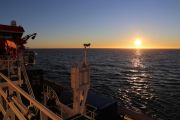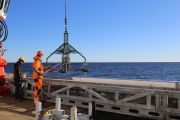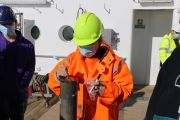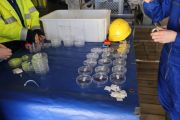
Home run for the RV Maria S. Merian:
Research vessel sets off towards the Baltic Sea ice
for the "Deep Baltic" mission
27.02.2021 – Bornholm Basin: Close to the end of the last ice age
We are on our way to the Bornholm Basin, the next deep basin east of the Darss Sill. If you sail the Baltic Sea from west to east, finally to northeast, deeper and deeper basins join behind the Darss Sill. After the Arkona Basin with about 50 m depth, the Bornholm Basin, east of the island of Bornholm, is already considerably deeper with about 80 m.
Many MUC operations are planned for today. MUC stands for multicorer - a device that can pull several short cores in one deployment. It is always used when the uppermost – the youngest - deposits are to be examined.
Svenja Papenmeier and Anina Hinz, who are responsible for sediment acoustics in the scientific team, spent the night analysing profiles to find a spot where the sediments above the Baltic Ice Lake are particularly thin.
The sediments of the Baltic Ice Lake are the first deposits after the disintegration of the ice sheet of the last ice age and were deposited about 10,000 years ago. They will continue to accompany us on our journey. Characteristic is their high clay and low organic content. They are beige-pink in colour and usually show warves typical of an ice lake - a seasonal stratification.
The sediment stack lying on these clays represents the post-glacial history of the Baltic Sea. Today we know very well how this sequence ideally looks like. We will report on that later. The big question is, why are there so few sediments overlying the lake sediments here? Obviously, most of it was eroded, but when? And where was the material transported? The assumption: winter deep water formation led to currents that periodically cleared the cover of the ice lake sediments. But there is no such deep winter overturning in the Bornholm Basin today. So when was it different and why?
The station where we deploy the MUC is perfect. The material we retrieve from the depths is soft and very dark - typical of the deposits of the last few centuries.
The contents of the tubes are transferred centimetre by centimetre into large Petri dishes and secured for later examination in Kiel. Henriette Kolling coordinates the sampling. She is particularly interested in biomarkers in the sediments - witnesses in the form of microfossils or special molecules that are considered to indicate very specific environmental conditions. In this way, conclusions can be drawn about the respective climatic regime. In combination with an age dating, it is then possible to assign them to one of the known post-glacial climate periods - such as the "Medieval Warm Period" or the "Little Ice Age". Everyone on board would like to have this information immediately! But the analysis is done at home. The most important thing is that the samples have been obtained and secured!
Text and photos by Barbara Hentzsch (IOW) | click photos to enlarge
| Expedition: | MSM99 |
| Mission: | Deep Baltic |
| Start: | 25.02.2021 - Emden |
| Destination: | 23.03.2021 - Emden |
Maria S. Merian: current position



